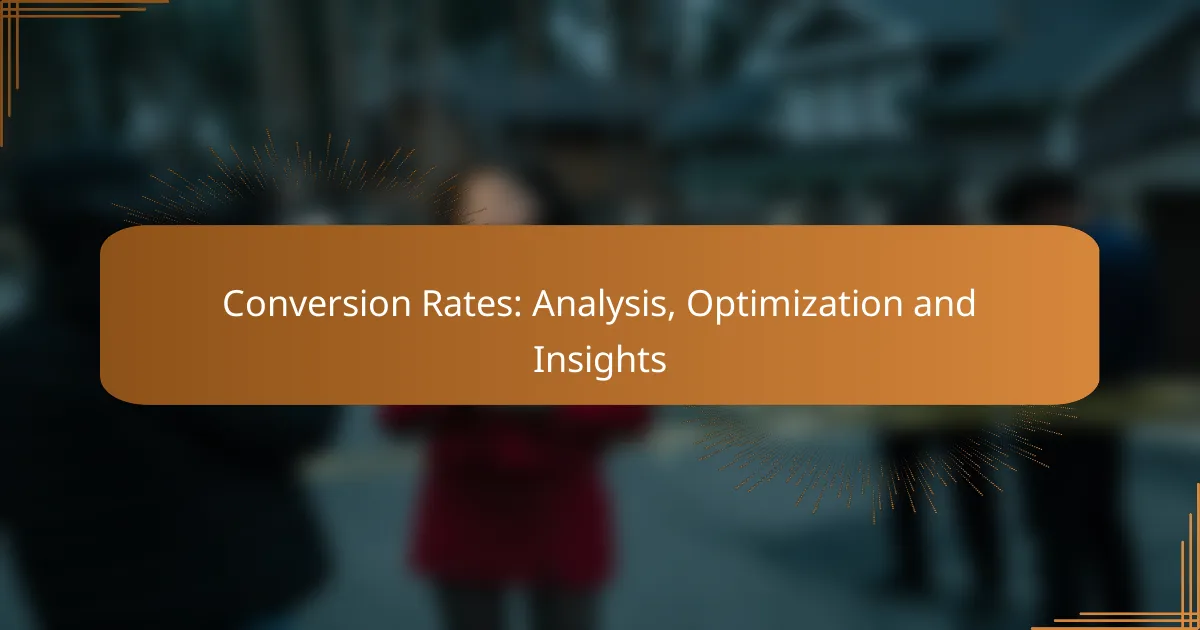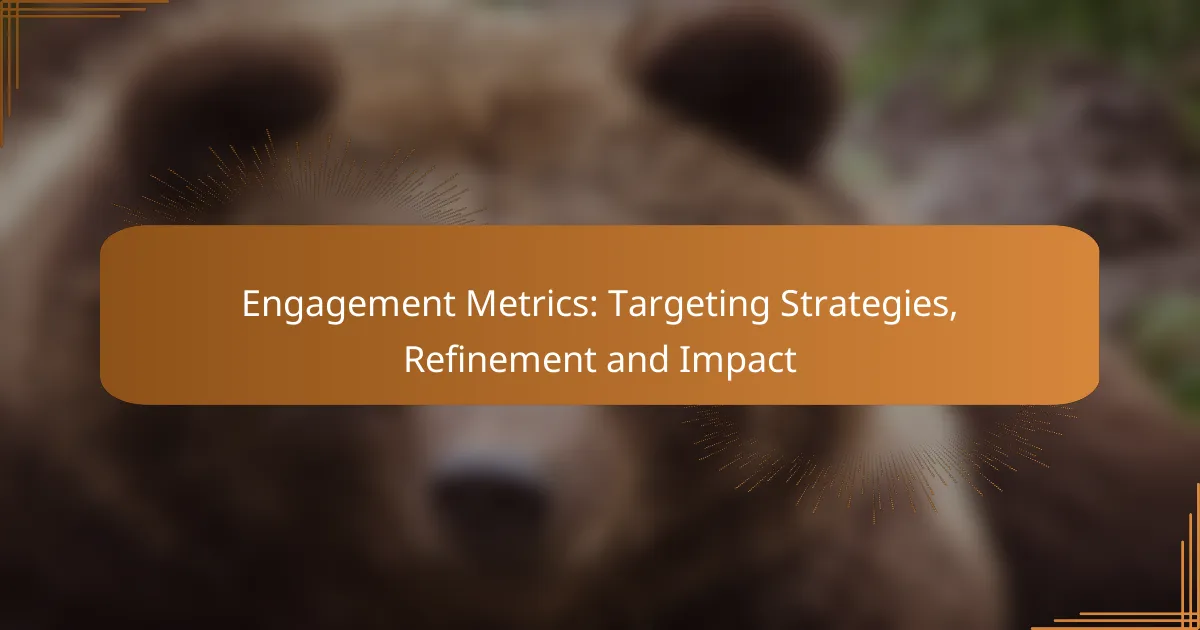Conversion rates are crucial indicators of marketing effectiveness, reflecting how well campaigns turn potential customers into actual buyers. By analyzing key metrics such as click-through rate (CTR) and cost per acquisition (CPA), businesses can identify areas for optimization. Implementing strategies like A/B testing and enhancing landing page experiences can significantly improve user engagement and drive higher conversions.

How to improve conversion rates in display advertising?
Improving conversion rates in display advertising involves optimizing various elements of your campaigns to encourage user engagement and action. Key strategies include A/B testing, optimizing ad placements, enhancing targeting strategies, improving landing page experiences, and leveraging retargeting campaigns.
Utilize A/B testing
A/B testing allows advertisers to compare two versions of an ad to determine which performs better. By changing one element at a time, such as the ad copy, images, or call-to-action, you can gather data on what resonates more with your audience.
Focus on testing significant changes that could impact conversion rates, such as different headlines or button colors. Aim for a sample size that provides statistically significant results, typically in the hundreds or thousands, depending on your traffic volume.
Optimize ad placements
Ad placements can significantly influence conversion rates. Positioning ads in high-visibility areas, such as above the fold or within content, can lead to better engagement. Analyze performance data to identify which placements yield the highest click-through rates.
Consider using programmatic advertising to automate placement decisions based on real-time performance metrics. This can help ensure your ads are shown in the most effective locations across various platforms.
Enhance targeting strategies
Effective targeting strategies ensure your ads reach the right audience. Utilize demographic, geographic, and behavioral data to refine your targeting. This can include targeting specific age groups, interests, or online behaviors that align with your product or service.
Employ tools like lookalike audiences to find new potential customers who share characteristics with your existing audience. This can increase the likelihood of conversions by reaching users more likely to be interested in your offerings.
Improve landing page experience
The landing page is crucial for converting clicks into actions. Ensure that your landing page is relevant to the ad content, loads quickly, and is mobile-friendly. A seamless user experience can significantly boost conversion rates.
Incorporate clear calls-to-action and minimize distractions on the landing page. Use concise messaging and visuals that align with your ad to maintain user interest and encourage them to complete the desired action.
Leverage retargeting campaigns
Retargeting campaigns allow you to re-engage users who have previously interacted with your ads or website. By showing tailored ads to these users, you can remind them of your offerings and encourage them to return and convert.
Set up retargeting ads that highlight specific products or services users viewed. This personalized approach can increase the chances of conversion, as it targets users who have already shown interest in your brand.

What are the key metrics for analyzing conversion rates?
Key metrics for analyzing conversion rates include click-through rate (CTR), cost per acquisition (CPA), and return on ad spend (ROAS). These metrics provide insights into the effectiveness of marketing efforts and help identify areas for improvement.
Click-through rate (CTR)
Click-through rate (CTR) measures the percentage of users who click on a specific link compared to the total number of users who view a page or advertisement. A higher CTR indicates that your content is engaging and relevant to your audience.
To calculate CTR, divide the number of clicks by the number of impressions and multiply by 100. For example, if an ad receives 100 clicks from 1,000 impressions, the CTR would be 10%. Aim for a CTR in the low to mid single digits for most industries, but this can vary significantly based on the sector.
To optimize CTR, focus on creating compelling headlines, using clear calls to action, and targeting the right audience. Avoid common pitfalls like vague messaging or irrelevant targeting, which can lead to lower engagement.
Cost per acquisition (CPA)
Cost per acquisition (CPA) measures the total cost of acquiring a customer through various marketing efforts. This metric helps businesses understand how much they are spending to convert leads into paying customers.
To calculate CPA, divide the total cost of your marketing campaign by the number of conversions. For instance, if you spend $1,000 on a campaign and acquire 50 customers, your CPA would be $20. A lower CPA indicates a more efficient marketing strategy.
To optimize CPA, consider testing different marketing channels and strategies. Focus on high-performing ads and avoid overspending on underperforming campaigns. Regularly analyze your CPA to ensure it aligns with your profit margins.
Return on ad spend (ROAS)
Return on ad spend (ROAS) measures the revenue generated for every dollar spent on advertising. This metric is crucial for assessing the profitability of your advertising campaigns.
To calculate ROAS, divide the total revenue generated from ads by the total ad spend. For example, if you earn $5,000 from a $1,000 ad spend, your ROAS would be 5:1. A ROAS of 4:1 or higher is generally considered effective, but this can vary by industry.
To improve ROAS, focus on targeting the right audience and optimizing ad creatives. Regularly review your campaigns to identify which ads yield the highest returns and allocate more budget to those efforts while cutting back on less effective ones.

What tools can help with conversion rate optimization?
Several tools can significantly enhance conversion rate optimization (CRO) efforts by providing insights into user behavior, facilitating A/B testing, and analyzing website performance. Utilizing the right combination of these tools can lead to improved user engagement and higher conversion rates.
Google Analytics
Google Analytics is a powerful tool for tracking website traffic and user behavior. It provides detailed reports on user demographics, acquisition channels, and conversion paths, allowing businesses to identify which areas of their site are performing well and which need improvement.
To optimize conversions, focus on metrics such as bounce rate, average session duration, and goal completions. Set up conversion tracking to measure specific actions, such as form submissions or product purchases, which can guide your optimization strategies.
Optimizely
Optimizely is a leading A/B testing platform that allows businesses to experiment with different versions of their web pages. By testing variations of headlines, images, and layouts, users can determine which elements lead to higher conversion rates.
When using Optimizely, prioritize tests that target high-traffic pages or critical conversion points. Keep tests simple and run them long enough to gather statistically significant data, ensuring that your findings are reliable before implementing changes.
Hotjar
Hotjar provides insights into user behavior through heatmaps, session recordings, and feedback polls. This tool helps visualize how users interact with your site, revealing areas where they may struggle or lose interest.
Utilize Hotjar’s heatmaps to identify popular sections of your pages and optimize layouts accordingly. Additionally, consider using feedback polls to gather direct insights from users about their experience, which can inform further CRO efforts.

What are common pitfalls in conversion rate optimization?
Common pitfalls in conversion rate optimization (CRO) can significantly hinder the effectiveness of your strategies. Failing to address these issues can lead to wasted resources and missed opportunities for improving conversion rates.
Ignoring mobile optimization
Ignoring mobile optimization is a critical mistake, as a substantial portion of web traffic now comes from mobile devices. Websites that are not mobile-friendly can frustrate users, leading to higher bounce rates and lower conversions.
To optimize for mobile, ensure your site is responsive, loads quickly, and provides a seamless user experience. Consider using larger buttons, simplified navigation, and minimizing text input to enhance usability on smaller screens.
Neglecting user experience
Neglecting user experience (UX) can deter potential customers from completing their purchases. A confusing layout, slow loading times, or excessive pop-ups can create barriers that prevent users from converting.
Focus on creating a clean, intuitive design that guides users toward their goals. Conduct usability testing to identify pain points and gather feedback to continuously improve the overall experience.
Overlooking data analysis
Overlooking data analysis can result in missed insights that are crucial for effective conversion rate optimization. Without analyzing user behavior, you may not understand what changes are necessary to improve performance.
Utilize tools like Google Analytics to track user interactions, conversion funnels, and drop-off points. Regularly review this data to make informed decisions and adjust your strategies based on what the numbers reveal.

How do audience segments affect conversion rates?
Audience segments significantly influence conversion rates by tailoring marketing efforts to specific groups. Understanding the characteristics and behaviors of different segments allows businesses to optimize their strategies, leading to improved engagement and higher conversion rates.
Understanding Audience Segmentation
Audience segmentation involves dividing a broad target market into smaller, more defined groups based on shared characteristics. These characteristics can include demographics, interests, purchasing behavior, and geographic location. By identifying these segments, businesses can create more personalized marketing messages that resonate with each group.
Impact on Conversion Rates
Different audience segments exhibit varying conversion rates due to their unique preferences and behaviors. For instance, younger audiences may respond better to social media campaigns, while older demographics might prefer email marketing. Tailoring your approach to these differences can lead to significant improvements in conversion rates, often ranging from low single digits to over 20% depending on the effectiveness of the strategy.
Strategies for Optimization
To optimize conversion rates across audience segments, consider implementing A/B testing to determine which messages and channels perform best for each group. Use analytics tools to track engagement and conversion metrics, allowing for data-driven adjustments. Additionally, ensure that your website and landing pages are user-friendly and relevant to the specific audience segment being targeted.
Common Pitfalls to Avoid
One common pitfall is assuming that all audience segments will respond similarly to marketing efforts. This can lead to wasted resources and missed opportunities. Another mistake is neglecting to update segmentation strategies based on changing consumer behaviors and market trends. Regularly revisiting and refining your audience segments is crucial for sustained success.


